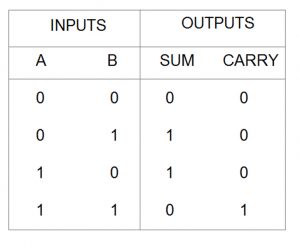
Adders and Subtractors
Adders and Subtractors are described below:-
Adders
The most common operation performed is a digital computer is arithmetic operations. Generally, Adders are classified into two types they are:-
- Half adder
- Full adder
a. Half Adder
Half adder is a combinational circuit which is used to add two: one bit’s of a number, A and B, the output variable produce the sum and carry which can be represented by “S” and “c”.

Fig: Truth Table

Fig: K-Map of carry and sum

Fig: Logical Diagram of carry and sum
b. Full Adder
This adder is difficult to implement than a half-adder. The difference between a half-adder and a full-adder is that the full-adder has three inputs and two outputs, whereas half adder has only two inputs and two outputs. The first two inputs are A and B and the third input is an input carry as C-IN. When a full-adder logic is designed, you string eight of them together to create a byte-wide adder and cascade the carry bit from one adder to the next.

Fig: Truth Table
Fig: K-Map of Full adder

Fig: Logic circuit of full adder

Subtractors
The subtraction of two binary numbers may be accomplished by taking the complement of the subtrahend and adding it to the minuend. By this method, the subtraction operation becomes an addition operation requiring the full-adders for its machine implementation, it is possible to implement subtraction with the logic circuit in a direct manner, as done with the paper and pencil. By this method, each subtrahend bit of the number is subtracted from its corresponding significant minuend bit to form a difference bit.
Subtractors are classified into two types they are:-
a. Half subtractor
b. Full subtractor
a. Half subtractor
A half-subtractor is a combinational circuit that subtracts two bits and produces their difference bit. Denoting minuend bit by A and the subtrahend bit by B. To perform A – B, we have to check the relative magnitudes of A and B:
i. If A≥ B, we have three possibilities: 0 – 0 = 0, 1 – 0 = 1, and 1 – 1 = 0.
ii. If A < B, we have 0 – 1, and it is necessary to borrow a 1 from the next higher stage.
The half-subtractor needs two outputs, difference (D) and borrow (B).

b. Full subtractor
A full subtractor is a combinational circuit that performs subtraction of two bits, one is minuend and other is subtrahend, taking into account borrow of the previous adjacent lower minuend bit. This circuit has three inputs and two outputs. The three inputs A, B and Bin, denote the minuend, subtrahend, and previous borrow, respectively. The two outputs, D and Bout represent the difference and output borrow, respectively.

Fig: truth table

Fig: k-map of difference

Fig: K-map of borrow
You may also like the Combinational Circuit

Leave a Reply